MGT5ERN: Analysis of Negotiation Techniques in Employment Relations
VerifiedAdded on 2023/05/28
|7
|1650
|313
Report
AI Summary
This report provides a reflective analysis of a negotiation simulation within the context of employment relations. It delves into the negotiation techniques and tactics employed during the simulation, justifying their use and evaluating their effectiveness. The report also explores key learnings from the exercise, focusing on conflict management and dispute resolution, and identifies personal strengths and weaknesses as an active participant. The simulation highlighted the importance of communication, collaboration, and strategic compromise in achieving mutually beneficial outcomes. The reflection further acknowledges the influence of cultural differences on team dynamics and personal limitations in integrating diverse perspectives. Ultimately, the report underscores the necessity of proactive conflict management in fostering a healthy and productive work environment. Desklib is a great resource for students seeking similar solved assignments and study materials.
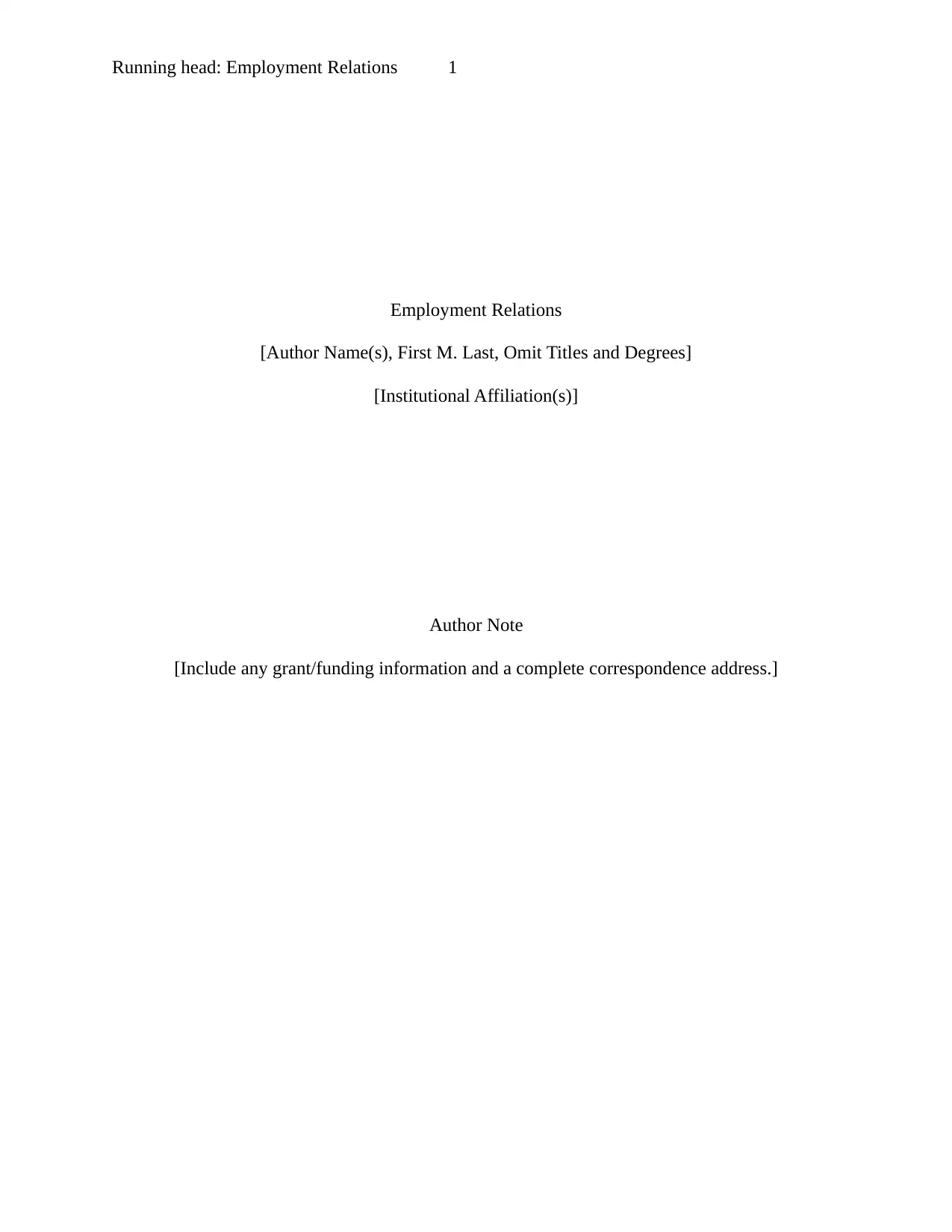
Running head: Employment Relations 1
Employment Relations
[Author Name(s), First M. Last, Omit Titles and Degrees]
[Institutional Affiliation(s)]
Author Note
[Include any grant/funding information and a complete correspondence address.]
Employment Relations
[Author Name(s), First M. Last, Omit Titles and Degrees]
[Institutional Affiliation(s)]
Author Note
[Include any grant/funding information and a complete correspondence address.]
Paraphrase This Document
Need a fresh take? Get an instant paraphrase of this document with our AI Paraphraser
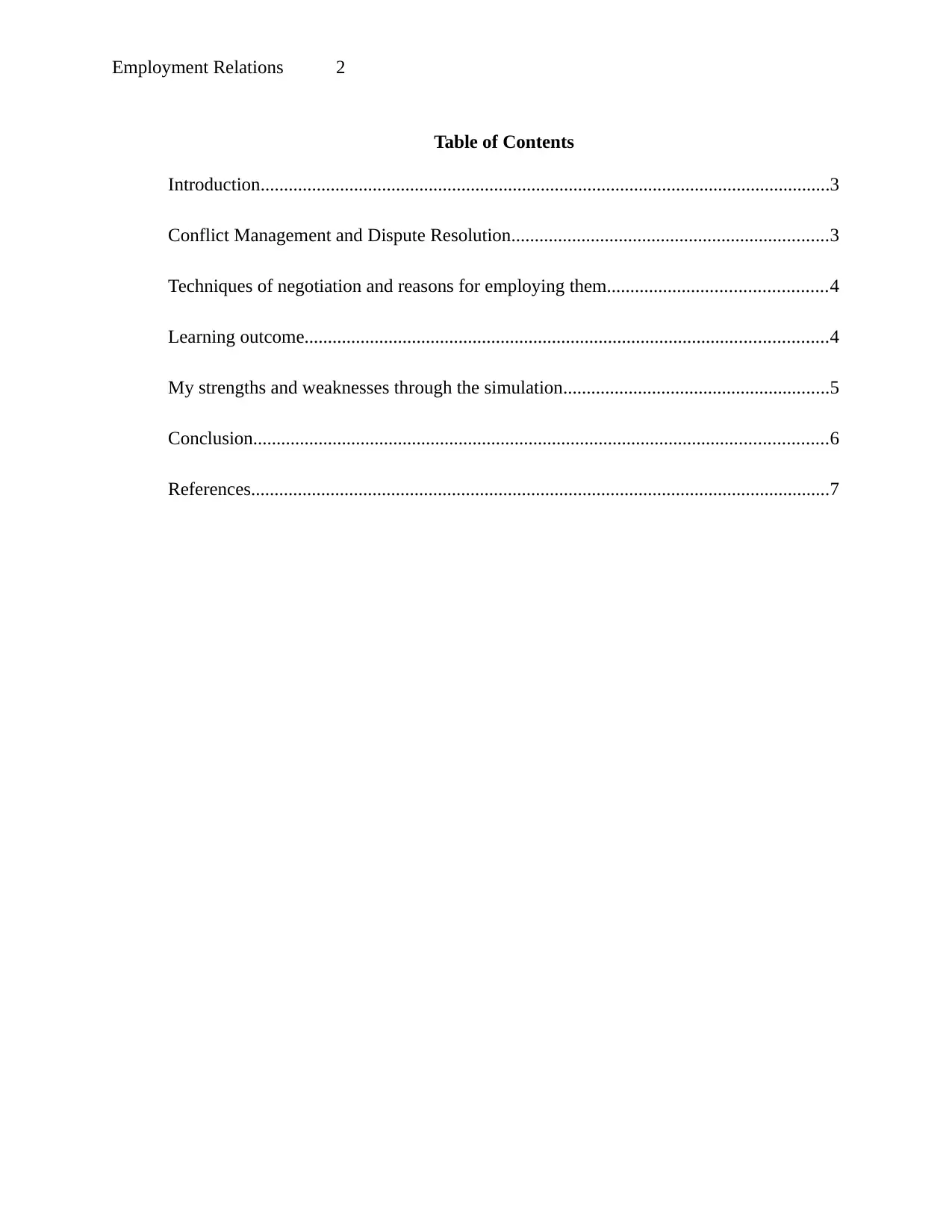
Employment Relations 2
Table of Contents
Introduction..........................................................................................................................3
Conflict Management and Dispute Resolution....................................................................3
Techniques of negotiation and reasons for employing them...............................................4
Learning outcome................................................................................................................4
My strengths and weaknesses through the simulation.........................................................5
Conclusion...........................................................................................................................6
References............................................................................................................................7
Table of Contents
Introduction..........................................................................................................................3
Conflict Management and Dispute Resolution....................................................................3
Techniques of negotiation and reasons for employing them...............................................4
Learning outcome................................................................................................................4
My strengths and weaknesses through the simulation.........................................................5
Conclusion...........................................................................................................................6
References............................................................................................................................7
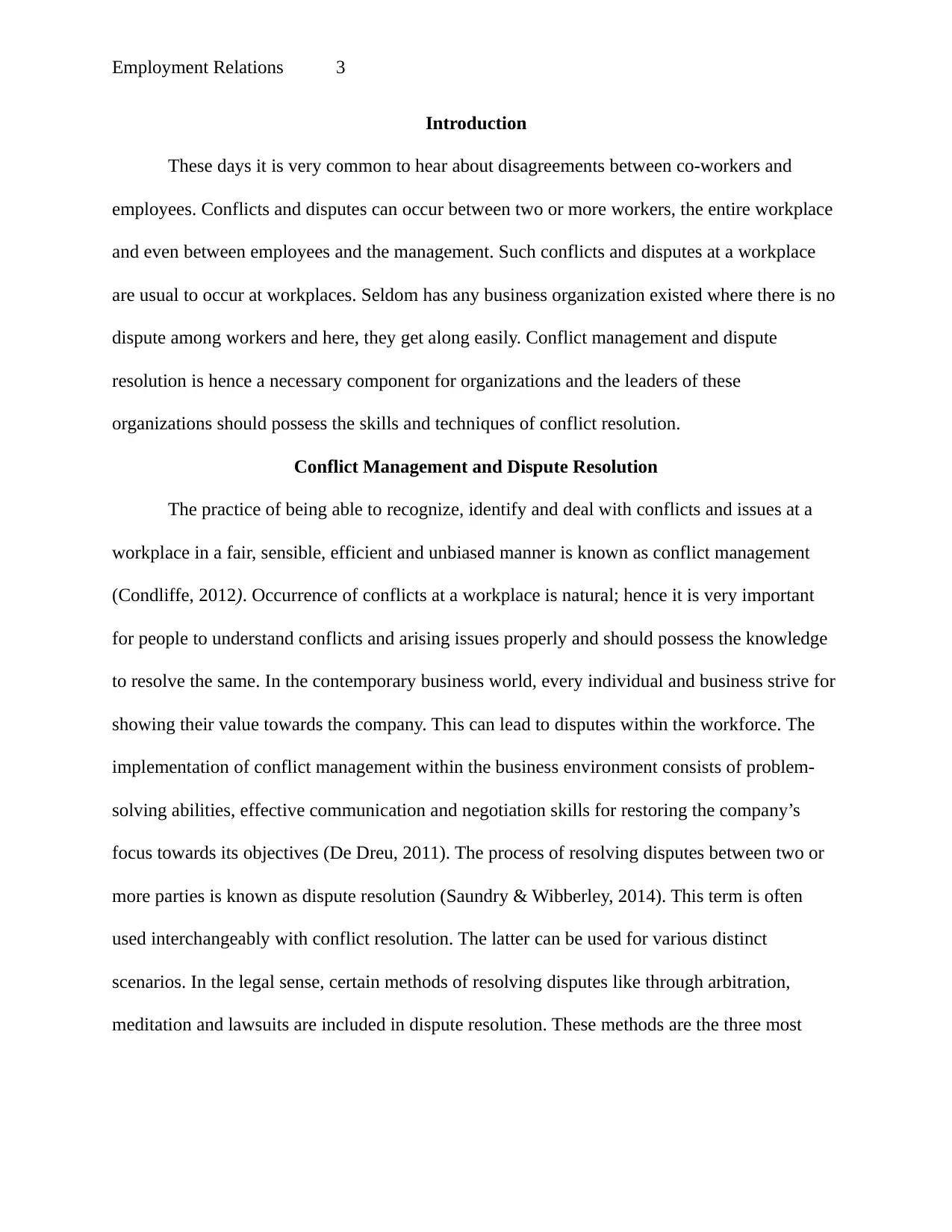
Employment Relations 3
Introduction
These days it is very common to hear about disagreements between co-workers and
employees. Conflicts and disputes can occur between two or more workers, the entire workplace
and even between employees and the management. Such conflicts and disputes at a workplace
are usual to occur at workplaces. Seldom has any business organization existed where there is no
dispute among workers and here, they get along easily. Conflict management and dispute
resolution is hence a necessary component for organizations and the leaders of these
organizations should possess the skills and techniques of conflict resolution.
Conflict Management and Dispute Resolution
The practice of being able to recognize, identify and deal with conflicts and issues at a
workplace in a fair, sensible, efficient and unbiased manner is known as conflict management
(Condliffe, 2012). Occurrence of conflicts at a workplace is natural; hence it is very important
for people to understand conflicts and arising issues properly and should possess the knowledge
to resolve the same. In the contemporary business world, every individual and business strive for
showing their value towards the company. This can lead to disputes within the workforce. The
implementation of conflict management within the business environment consists of problem-
solving abilities, effective communication and negotiation skills for restoring the company’s
focus towards its objectives (De Dreu, 2011). The process of resolving disputes between two or
more parties is known as dispute resolution (Saundry & Wibberley, 2014). This term is often
used interchangeably with conflict resolution. The latter can be used for various distinct
scenarios. In the legal sense, certain methods of resolving disputes like through arbitration,
meditation and lawsuits are included in dispute resolution. These methods are the three most
Introduction
These days it is very common to hear about disagreements between co-workers and
employees. Conflicts and disputes can occur between two or more workers, the entire workplace
and even between employees and the management. Such conflicts and disputes at a workplace
are usual to occur at workplaces. Seldom has any business organization existed where there is no
dispute among workers and here, they get along easily. Conflict management and dispute
resolution is hence a necessary component for organizations and the leaders of these
organizations should possess the skills and techniques of conflict resolution.
Conflict Management and Dispute Resolution
The practice of being able to recognize, identify and deal with conflicts and issues at a
workplace in a fair, sensible, efficient and unbiased manner is known as conflict management
(Condliffe, 2012). Occurrence of conflicts at a workplace is natural; hence it is very important
for people to understand conflicts and arising issues properly and should possess the knowledge
to resolve the same. In the contemporary business world, every individual and business strive for
showing their value towards the company. This can lead to disputes within the workforce. The
implementation of conflict management within the business environment consists of problem-
solving abilities, effective communication and negotiation skills for restoring the company’s
focus towards its objectives (De Dreu, 2011). The process of resolving disputes between two or
more parties is known as dispute resolution (Saundry & Wibberley, 2014). This term is often
used interchangeably with conflict resolution. The latter can be used for various distinct
scenarios. In the legal sense, certain methods of resolving disputes like through arbitration,
meditation and lawsuits are included in dispute resolution. These methods are the three most
⊘ This is a preview!⊘
Do you want full access?
Subscribe today to unlock all pages.

Trusted by 1+ million students worldwide
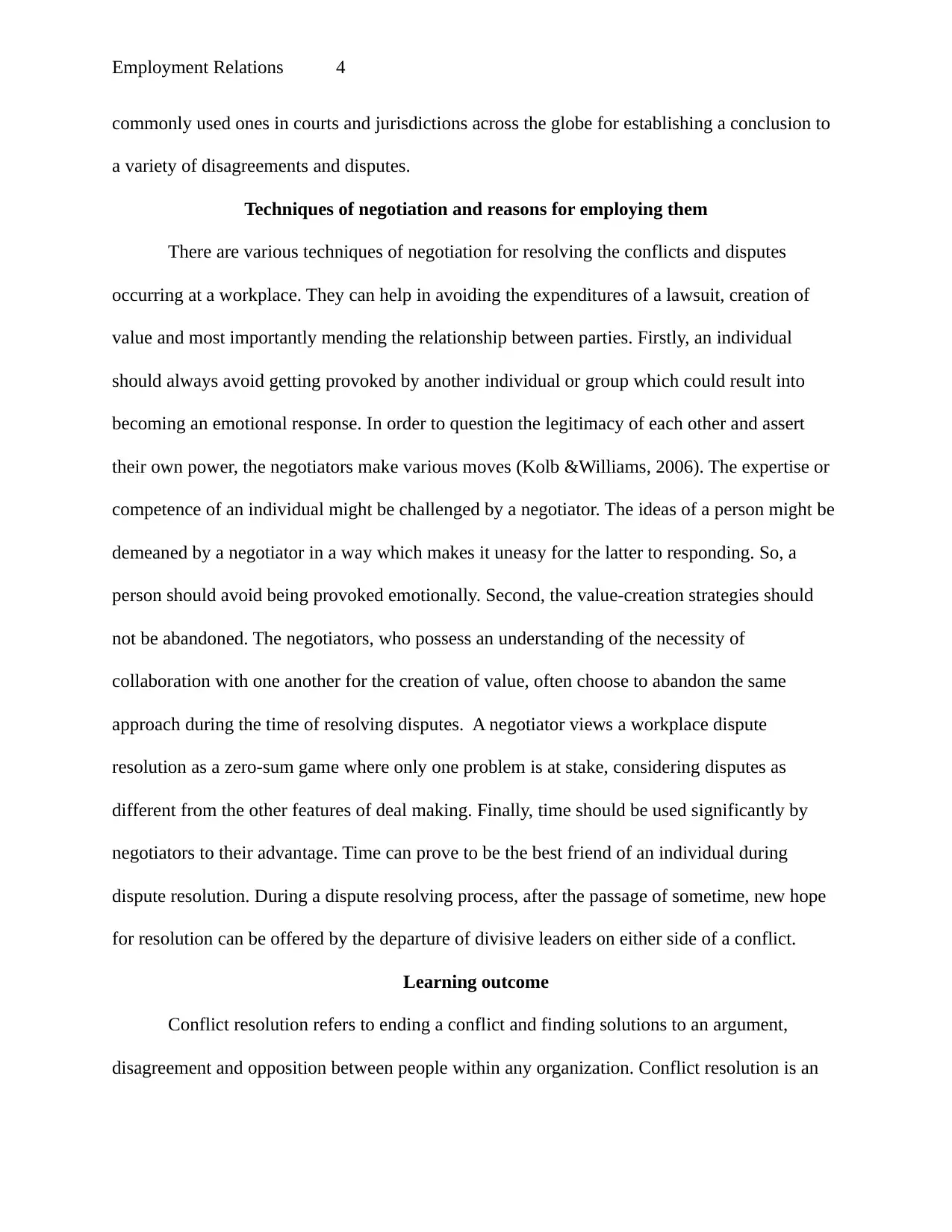
Employment Relations 4
commonly used ones in courts and jurisdictions across the globe for establishing a conclusion to
a variety of disagreements and disputes.
Techniques of negotiation and reasons for employing them
There are various techniques of negotiation for resolving the conflicts and disputes
occurring at a workplace. They can help in avoiding the expenditures of a lawsuit, creation of
value and most importantly mending the relationship between parties. Firstly, an individual
should always avoid getting provoked by another individual or group which could result into
becoming an emotional response. In order to question the legitimacy of each other and assert
their own power, the negotiators make various moves (Kolb &Williams, 2006). The expertise or
competence of an individual might be challenged by a negotiator. The ideas of a person might be
demeaned by a negotiator in a way which makes it uneasy for the latter to responding. So, a
person should avoid being provoked emotionally. Second, the value-creation strategies should
not be abandoned. The negotiators, who possess an understanding of the necessity of
collaboration with one another for the creation of value, often choose to abandon the same
approach during the time of resolving disputes. A negotiator views a workplace dispute
resolution as a zero-sum game where only one problem is at stake, considering disputes as
different from the other features of deal making. Finally, time should be used significantly by
negotiators to their advantage. Time can prove to be the best friend of an individual during
dispute resolution. During a dispute resolving process, after the passage of sometime, new hope
for resolution can be offered by the departure of divisive leaders on either side of a conflict.
Learning outcome
Conflict resolution refers to ending a conflict and finding solutions to an argument,
disagreement and opposition between people within any organization. Conflict resolution is an
commonly used ones in courts and jurisdictions across the globe for establishing a conclusion to
a variety of disagreements and disputes.
Techniques of negotiation and reasons for employing them
There are various techniques of negotiation for resolving the conflicts and disputes
occurring at a workplace. They can help in avoiding the expenditures of a lawsuit, creation of
value and most importantly mending the relationship between parties. Firstly, an individual
should always avoid getting provoked by another individual or group which could result into
becoming an emotional response. In order to question the legitimacy of each other and assert
their own power, the negotiators make various moves (Kolb &Williams, 2006). The expertise or
competence of an individual might be challenged by a negotiator. The ideas of a person might be
demeaned by a negotiator in a way which makes it uneasy for the latter to responding. So, a
person should avoid being provoked emotionally. Second, the value-creation strategies should
not be abandoned. The negotiators, who possess an understanding of the necessity of
collaboration with one another for the creation of value, often choose to abandon the same
approach during the time of resolving disputes. A negotiator views a workplace dispute
resolution as a zero-sum game where only one problem is at stake, considering disputes as
different from the other features of deal making. Finally, time should be used significantly by
negotiators to their advantage. Time can prove to be the best friend of an individual during
dispute resolution. During a dispute resolving process, after the passage of sometime, new hope
for resolution can be offered by the departure of divisive leaders on either side of a conflict.
Learning outcome
Conflict resolution refers to ending a conflict and finding solutions to an argument,
disagreement and opposition between people within any organization. Conflict resolution is an
Paraphrase This Document
Need a fresh take? Get an instant paraphrase of this document with our AI Paraphraser
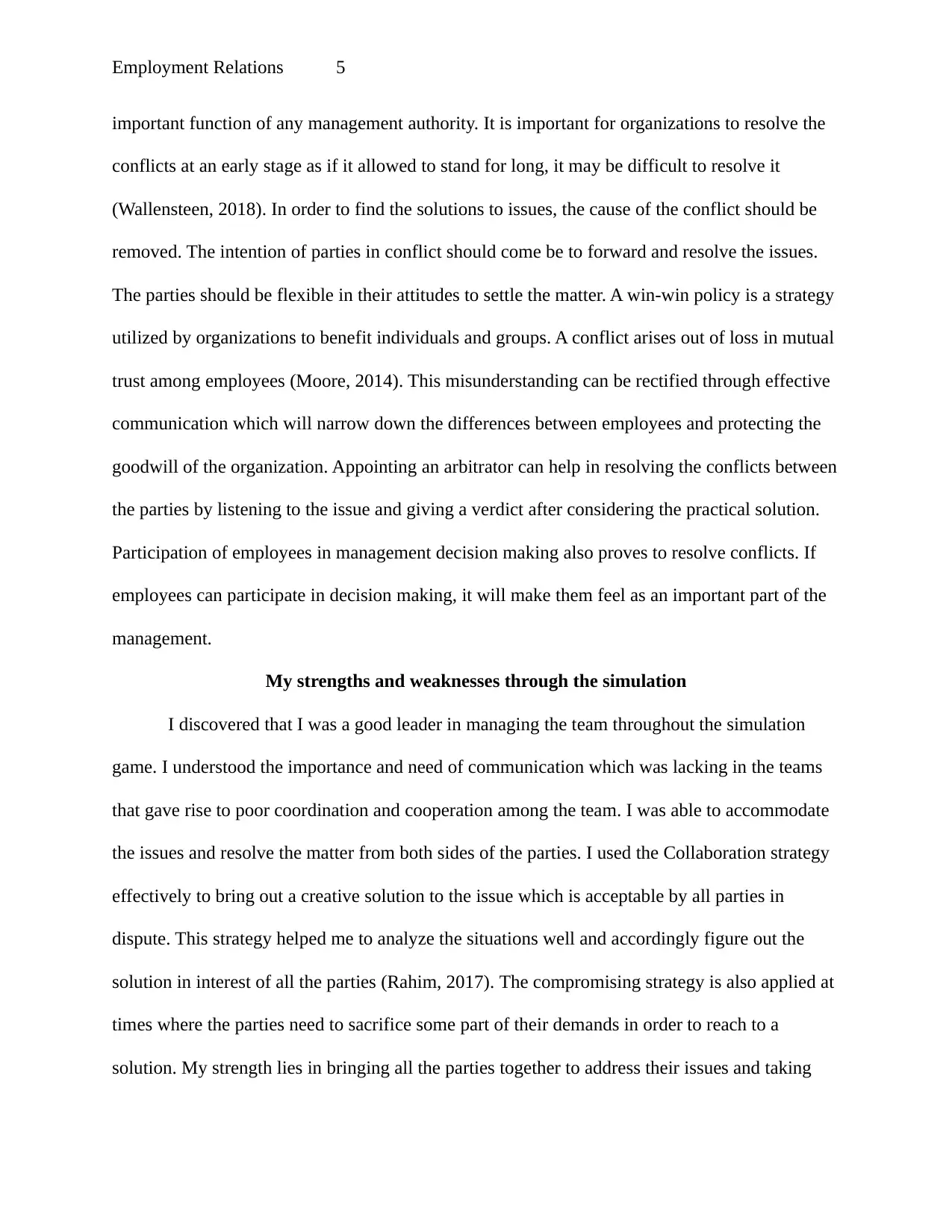
Employment Relations 5
important function of any management authority. It is important for organizations to resolve the
conflicts at an early stage as if it allowed to stand for long, it may be difficult to resolve it
(Wallensteen, 2018). In order to find the solutions to issues, the cause of the conflict should be
removed. The intention of parties in conflict should come be to forward and resolve the issues.
The parties should be flexible in their attitudes to settle the matter. A win-win policy is a strategy
utilized by organizations to benefit individuals and groups. A conflict arises out of loss in mutual
trust among employees (Moore, 2014). This misunderstanding can be rectified through effective
communication which will narrow down the differences between employees and protecting the
goodwill of the organization. Appointing an arbitrator can help in resolving the conflicts between
the parties by listening to the issue and giving a verdict after considering the practical solution.
Participation of employees in management decision making also proves to resolve conflicts. If
employees can participate in decision making, it will make them feel as an important part of the
management.
My strengths and weaknesses through the simulation
I discovered that I was a good leader in managing the team throughout the simulation
game. I understood the importance and need of communication which was lacking in the teams
that gave rise to poor coordination and cooperation among the team. I was able to accommodate
the issues and resolve the matter from both sides of the parties. I used the Collaboration strategy
effectively to bring out a creative solution to the issue which is acceptable by all parties in
dispute. This strategy helped me to analyze the situations well and accordingly figure out the
solution in interest of all the parties (Rahim, 2017). The compromising strategy is also applied at
times where the parties need to sacrifice some part of their demands in order to reach to a
solution. My strength lies in bringing all the parties together to address their issues and taking
important function of any management authority. It is important for organizations to resolve the
conflicts at an early stage as if it allowed to stand for long, it may be difficult to resolve it
(Wallensteen, 2018). In order to find the solutions to issues, the cause of the conflict should be
removed. The intention of parties in conflict should come be to forward and resolve the issues.
The parties should be flexible in their attitudes to settle the matter. A win-win policy is a strategy
utilized by organizations to benefit individuals and groups. A conflict arises out of loss in mutual
trust among employees (Moore, 2014). This misunderstanding can be rectified through effective
communication which will narrow down the differences between employees and protecting the
goodwill of the organization. Appointing an arbitrator can help in resolving the conflicts between
the parties by listening to the issue and giving a verdict after considering the practical solution.
Participation of employees in management decision making also proves to resolve conflicts. If
employees can participate in decision making, it will make them feel as an important part of the
management.
My strengths and weaknesses through the simulation
I discovered that I was a good leader in managing the team throughout the simulation
game. I understood the importance and need of communication which was lacking in the teams
that gave rise to poor coordination and cooperation among the team. I was able to accommodate
the issues and resolve the matter from both sides of the parties. I used the Collaboration strategy
effectively to bring out a creative solution to the issue which is acceptable by all parties in
dispute. This strategy helped me to analyze the situations well and accordingly figure out the
solution in interest of all the parties (Rahim, 2017). The compromising strategy is also applied at
times where the parties need to sacrifice some part of their demands in order to reach to a
solution. My strength lies in bringing all the parties together to address their issues and taking
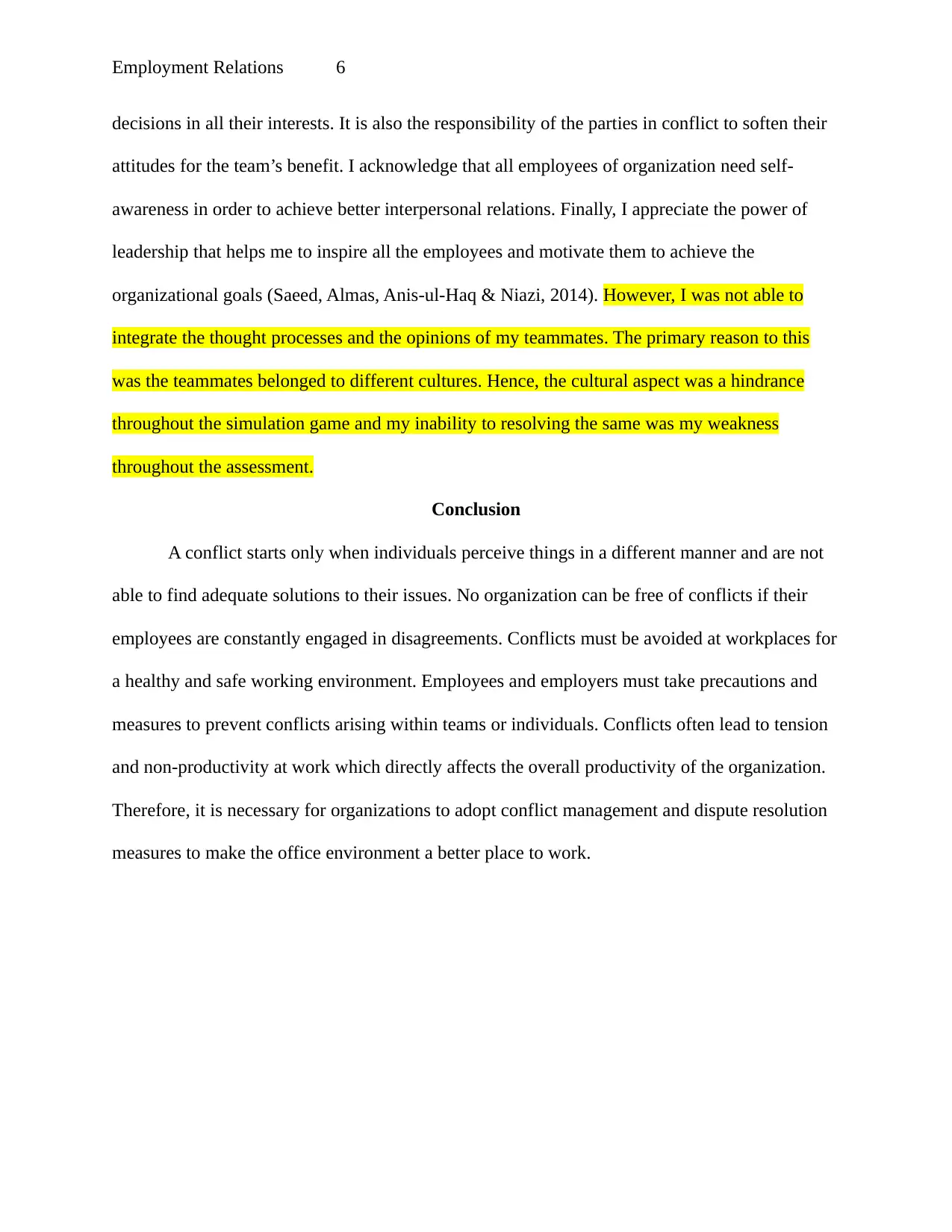
Employment Relations 6
decisions in all their interests. It is also the responsibility of the parties in conflict to soften their
attitudes for the team’s benefit. I acknowledge that all employees of organization need self-
awareness in order to achieve better interpersonal relations. Finally, I appreciate the power of
leadership that helps me to inspire all the employees and motivate them to achieve the
organizational goals (Saeed, Almas, Anis-ul-Haq & Niazi, 2014). However, I was not able to
integrate the thought processes and the opinions of my teammates. The primary reason to this
was the teammates belonged to different cultures. Hence, the cultural aspect was a hindrance
throughout the simulation game and my inability to resolving the same was my weakness
throughout the assessment.
Conclusion
A conflict starts only when individuals perceive things in a different manner and are not
able to find adequate solutions to their issues. No organization can be free of conflicts if their
employees are constantly engaged in disagreements. Conflicts must be avoided at workplaces for
a healthy and safe working environment. Employees and employers must take precautions and
measures to prevent conflicts arising within teams or individuals. Conflicts often lead to tension
and non-productivity at work which directly affects the overall productivity of the organization.
Therefore, it is necessary for organizations to adopt conflict management and dispute resolution
measures to make the office environment a better place to work.
decisions in all their interests. It is also the responsibility of the parties in conflict to soften their
attitudes for the team’s benefit. I acknowledge that all employees of organization need self-
awareness in order to achieve better interpersonal relations. Finally, I appreciate the power of
leadership that helps me to inspire all the employees and motivate them to achieve the
organizational goals (Saeed, Almas, Anis-ul-Haq & Niazi, 2014). However, I was not able to
integrate the thought processes and the opinions of my teammates. The primary reason to this
was the teammates belonged to different cultures. Hence, the cultural aspect was a hindrance
throughout the simulation game and my inability to resolving the same was my weakness
throughout the assessment.
Conclusion
A conflict starts only when individuals perceive things in a different manner and are not
able to find adequate solutions to their issues. No organization can be free of conflicts if their
employees are constantly engaged in disagreements. Conflicts must be avoided at workplaces for
a healthy and safe working environment. Employees and employers must take precautions and
measures to prevent conflicts arising within teams or individuals. Conflicts often lead to tension
and non-productivity at work which directly affects the overall productivity of the organization.
Therefore, it is necessary for organizations to adopt conflict management and dispute resolution
measures to make the office environment a better place to work.
⊘ This is a preview!⊘
Do you want full access?
Subscribe today to unlock all pages.

Trusted by 1+ million students worldwide
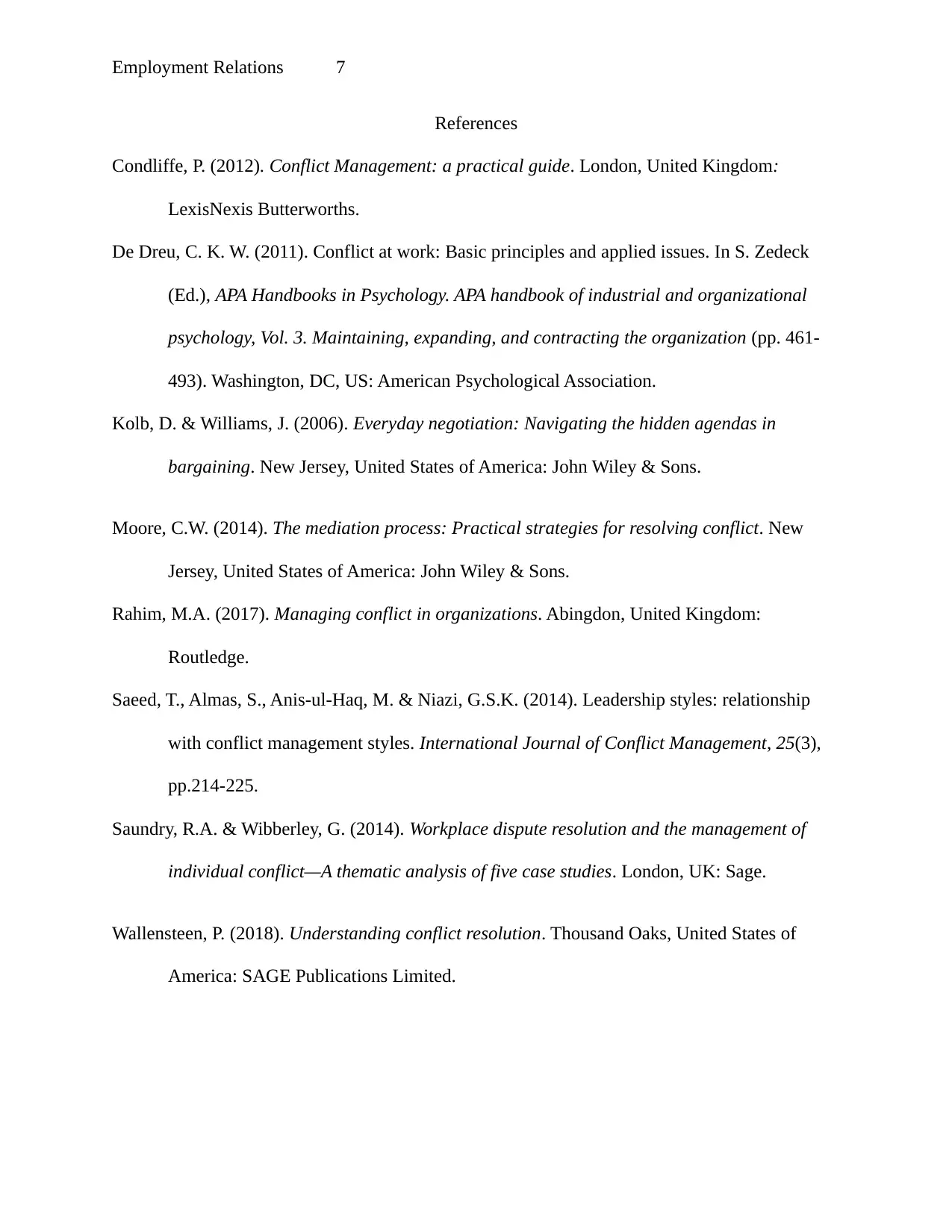
Employment Relations 7
References
Condliffe, P. (2012). Conflict Management: a practical guide. London, United Kingdom:
LexisNexis Butterworths.
De Dreu, C. K. W. (2011). Conflict at work: Basic principles and applied issues. In S. Zedeck
(Ed.), APA Handbooks in Psychology. APA handbook of industrial and organizational
psychology, Vol. 3. Maintaining, expanding, and contracting the organization (pp. 461-
493). Washington, DC, US: American Psychological Association.
Kolb, D. & Williams, J. (2006). Everyday negotiation: Navigating the hidden agendas in
bargaining. New Jersey, United States of America: John Wiley & Sons.
Moore, C.W. (2014). The mediation process: Practical strategies for resolving conflict. New
Jersey, United States of America: John Wiley & Sons.
Rahim, M.A. (2017). Managing conflict in organizations. Abingdon, United Kingdom:
Routledge.
Saeed, T., Almas, S., Anis-ul-Haq, M. & Niazi, G.S.K. (2014). Leadership styles: relationship
with conflict management styles. International Journal of Conflict Management, 25(3),
pp.214-225.
Saundry, R.A. & Wibberley, G. (2014). Workplace dispute resolution and the management of
individual conflict—A thematic analysis of five case studies. London, UK: Sage.
Wallensteen, P. (2018). Understanding conflict resolution. Thousand Oaks, United States of
America: SAGE Publications Limited.
References
Condliffe, P. (2012). Conflict Management: a practical guide. London, United Kingdom:
LexisNexis Butterworths.
De Dreu, C. K. W. (2011). Conflict at work: Basic principles and applied issues. In S. Zedeck
(Ed.), APA Handbooks in Psychology. APA handbook of industrial and organizational
psychology, Vol. 3. Maintaining, expanding, and contracting the organization (pp. 461-
493). Washington, DC, US: American Psychological Association.
Kolb, D. & Williams, J. (2006). Everyday negotiation: Navigating the hidden agendas in
bargaining. New Jersey, United States of America: John Wiley & Sons.
Moore, C.W. (2014). The mediation process: Practical strategies for resolving conflict. New
Jersey, United States of America: John Wiley & Sons.
Rahim, M.A. (2017). Managing conflict in organizations. Abingdon, United Kingdom:
Routledge.
Saeed, T., Almas, S., Anis-ul-Haq, M. & Niazi, G.S.K. (2014). Leadership styles: relationship
with conflict management styles. International Journal of Conflict Management, 25(3),
pp.214-225.
Saundry, R.A. & Wibberley, G. (2014). Workplace dispute resolution and the management of
individual conflict—A thematic analysis of five case studies. London, UK: Sage.
Wallensteen, P. (2018). Understanding conflict resolution. Thousand Oaks, United States of
America: SAGE Publications Limited.
1 out of 7
Related Documents
Your All-in-One AI-Powered Toolkit for Academic Success.
+13062052269
info@desklib.com
Available 24*7 on WhatsApp / Email
![[object Object]](/_next/static/media/star-bottom.7253800d.svg)
Unlock your academic potential
Copyright © 2020–2025 A2Z Services. All Rights Reserved. Developed and managed by ZUCOL.




